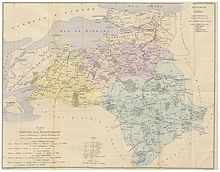
The Sanjak of Kocaeli was a second-level Ottoman province ( sanjak or liva ) with capital at Iznikmid/Izmid (Byzantine Nicomedia, modern Izmit).

The Sanjak of Kocaeli was a second-level Ottoman province ( sanjak or liva ) with capital at Iznikmid/Izmid (Byzantine Nicomedia, modern Izmit).
Kocaeli derives its name from Akça Khodja, an Ottoman Turkish warleader who began the conquest of the region from the Byzantine Empire. His domain (in Turkish Koca-ili or Koca-eli, "land of the Khodja") was recognized as a sanjak , already during the reign of Orhan I, sometime between 1327–1338, making it one of the earliest sanjaks of the Ottoman Empire. [1] [2] Its capital was Iznikmid (Nicomedia, modern Izmit), which was conquered by the Ottomans sometime between 1331 and 1338. [3] With the establishment of the Anatolia Eyalet it became part of it until 1533, when it was added to the newly created Eyalet of the Archipelago. [4] The woods of the province allowed the city to become the site of a major naval arsenal, especially during the Köprülü era. [2] [3]
It remained part of the Eyalet of the Archipelago until the Tanzimat reforms of the 19th century; by 1846, it had been transferred to the Kastamonu Eyalet. [4] In 1855 it passed to Hüdavendigâr Eyalet (and its successor Hüdavendigâr Vilayet after 1867). [5] From there it was transferred to the Istanbul Vilayet in 1870, before returning briefly to Hüdavendigâr (1871), becoming an independent sanjak in 1872, and returning to Istanbul in 1876. In 1887, the Sanjak of Kocaeli (increasingly known as Izmid, after its capital) returned to the jurisdiction of the Hüdavendigâr Vilayet. [6]

A sanjak was an administrative division of the Ottoman Empire. The Ottomans also sometimes called the sanjak a liva from the name's calque in Arabic and Persian.

The Kapudan Pasha, also known as the Kapudan-ı Derya was the Grand Admiral of the navy of the Ottoman Empire. Typically, he was based at Galata and Gallipoli during the winter and charged with annual sailings during the summer months. The title of Kapudan Pasha itself is only attested from 1567 onwards; earlier designations for the supreme commander of the fleet include Derya Bey and Re'is Kapudan.

The Vilayet of the Archipelago was a first-level administrative division (vilayet) of the Ottoman Empire extant from 1867 to 1912–13, including, at its maximum extent, the Ottoman Aegean islands, Cyprus and the Dardanelles Strait.

A vilayet, also known by various other names, was a first-order administrative division of the later Ottoman Empire. It was introduced in the Vilayet Law of 21 January 1867, part of the Tanzimat reform movement initiated by the Ottoman Reform Edict of 1856. The Danube Vilayet had been specially formed in 1864 as an experiment under the leading reformer Midhat Pasha. The Vilayet Law expanded its use, but it was not until 1884 that it was applied to all of the empire's provinces. Writing for the Encyclopaedia Britannica in 1911, Vincent Henry Penalver Caillard claimed that the reform had intended to provide the provinces with greater amounts of local self-government but in fact had the effect of centralizing more power with the sultan and local Muslims at the expense of other communities.

The Eyalet of Rumeli, or Eyalet ofRumelia, known as the Beylerbeylik of Rumeli until 1591, was a first-level province of the Ottoman Empire encompassing most of the Balkans ("Rumelia"). For most of its history, it was the largest and most important province of the Empire, containing key cities such as Edirne, Yanina (Ioannina), Sofia, Filibe (Plovdiv), Manastır/Monastir (Bitola), Üsküp (Skopje), and the major seaport of Selânik/Salonica (Thessaloniki). It was also among the oldest Ottoman eyalets, lasting more than 500 years with several territorial restructurings over the long course of its existence.

The Eyalet of the Morea was a first-level province (eyalet) of the Ottoman Empire, centred on the Peloponnese peninsula in southern Greece.
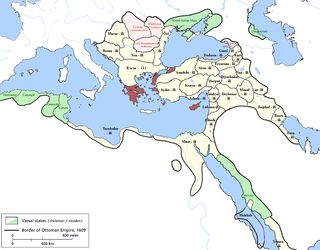
The Eyalet of the Islands of the White Sea was a first-level province (eyalet) of the Ottoman Empire. From its inception until the Tanzimat reforms of the mid-19th century, it was under the personal control of the Kapudan Pasha, the commander-in-chief of the Ottoman Navy.
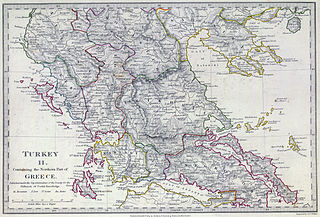
Karli-Eli, also Karli-Ili or Karlo-Ili, was the Ottoman name for the region of Aetolia-Acarnania in Western Greece, which formed a distinct administrative unit from the late 15th century until the Greek War of Independence.
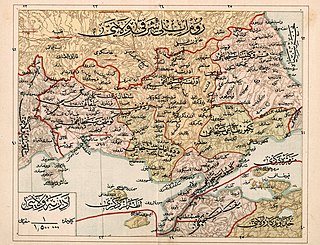
The Sanjak of Dedeağaç, originally in 1878–1884 the Sanjak of Dimetoka, was a second-level province (sanjak) of the Ottoman Empire in Thrace, forming part of the Adrianople Vilayet. Its capital was Dedeağaç, modern Alexandroupolis in Greece.

The Sanjak of Tirhala or Trikala was second-level Ottoman province encompassing the region of Thessaly. Its name derives from the Turkish version of the name of the town of Trikala. It was established after the conquest of Thessaly by the Ottomans led by Turahan Bey, a process which began at the end of the 14th century and ended in the mid-15th century.

The Sanjak of Sakız or Chios was a second-level Ottoman province centred on the eastern Aegean island of Chios. Its Turkish name, Sakız, derived from the island's most distinctive product, gum mastic.

The Sanjak of Preveza, also once known as the Liva of Preveza, was a sanjak of the Ottoman Empire named for its capital at Preveza in southern Epirus, now part of northwestern Greece. The sanjak existed from its formation in 1863 until its conquest in the First Balkan War and reorganization in 1915 as the Preveza Prefecture of the Kingdom of Greece.

The Sanjak of Rodos or Rhodes was a second-level Ottoman province encompassing the Dodecanese or Southern Sporades islands, with Rhodes as its centre.

The Sanjak of Gelibolu or Gallipoli was a second-level Ottoman province encompassing the Gallipoli Peninsula and a portion of southern Thrace. Gelibolu was the first Ottoman province in Europe, and for over a century the main base of the Ottoman Navy. Thereafter, and until the 18th century, it served as the seat of the Kapudan Pasha and capital of the Eyalet of the Archipelago.
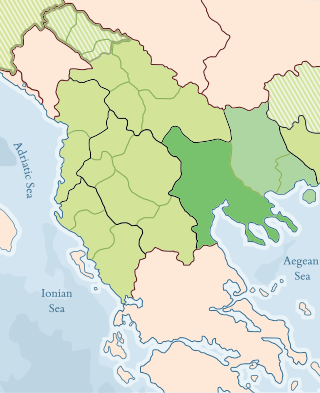
The Sanjak of Salonica, Selanik, or Thessalonica was a sanjak of the Ottoman Empire. It was named for its capital Salonica, also known by its Turkish name Selanik and its latinized Greek name Thessalonica. It was also known under the Ottomans as the Liva of Salonica &c.. The sanjak existed from its formation in 1430 as part of the Rumeli Eyalet until its conquest in the First Balkan War in 1912 and its reorganization in 1915 as the Thessalonica Prefecture of the Kingdom of Greece. It served as the pasha sanjak of the Eyalet of Salonica from 1846–1867 and of the Vilayet of Salonica from 1867–1912.
The Sanjak of Nakşa Berre or Naxos was a second-level Ottoman province encompassing the central and southern Cyclades islands, and named after the two largest islands of Naxos and Paros. The sanjak encompassed the territory of the former Duchy of Naxos, which had been tributary to the Ottomans since 1537, but was not formally incorporated into the Empire until after 1579, when the last Duke, Joseph Nasi, died. The sanjak formed part of the Eyalet of the Archipelago at least by 1600, but is no longer attested after the late 18th century. Aside from the sanjakbey at Naxos, two other beys, at Milos and Santorini, are recorded in 1629. With the outbreak of the Greek War of Independence in 1821, the islands came under Greek control.
The Sanjak of Kavala was a second-level Ottoman province encompassing the region around the port town of Kavala in eastern Macedonia.
The Sanjak of Ankara was a second-level province (sanjak) of the Ottoman Empire.
The Sanjak of Kütahya was a second-level province (sanjak) of the Ottoman Empire.

The Sanjak of Biga was a second-level Ottoman province, roughly corresponding to the modern Çanakkale Province of Turkey.